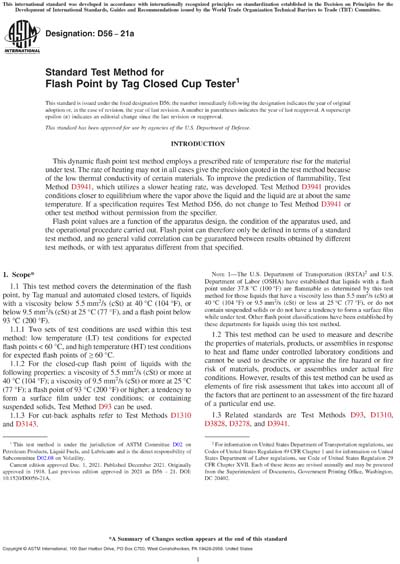Historical
ASTM D56-21a
Standard Test Method for Flash Point by Tag Closed Cup Tester
1.1This test method covers the determination of the flash point, by Tag manual and automated closed testers, of liquids with a viscosity below 5.5 mm2/s (cSt) at 40 °C (104 °F), or below 9.5 mm2/s (cSt) at 25 °C (77 °F), and a flash point below 93 °C (200 °F).
1.1.1Two sets of test conditions are used within this test method: low temperature (LT) test conditions for expected flash points < 60 °C, and high temperature (HT) test conditions for expected flash points of ‰¥ 60 °C.
1.1.2For the closed-cup flash point of liquids with the following properties: a viscosity of 5.5 mm2/s (cSt) or more at 40 °C (104 °F); a viscosity of 9.5 mm2/s (cSt) or more at 25 °C (77 °F); a flash point of 93 °C (200 °F) or higher; a tendency to form a surface film under test conditions; or containing suspended solids, Test Method D93 can be used.
1.1.3For cut-back asphalts refer to Test Methods D1310 and D3143.
Note 1:The U.S. Department of Transportation (RSTA)2 and U.S. Department of Labor (OSHA) have established that liquids with a flash point under 37.8 °C (100 °F) are flammable as determined by this test method for those liquids that have a viscosity less than 5.5 mm2/s (cSt) at 40 °C (104 °F) or 9.5 mm2/s (cSt) or less at 25 °C (77 °F), or do not contain suspended solids or do not have a tendency to form a surface film while under test. Other flash point classifications have been established by these departments for liquids using this test method.
1.2This test method can be used to measure and describe the properties of materials, products, or assemblies in response to heat and flame under controlled laboratory conditions and cannot be used to describe or appraise the fire hazard or fire risk of materials, products, or assemblies under actual fire conditions. However, results of this test method can be used as elements of fire risk assessment that takes into account all of the factors that are pertinent to an assessment of the fire hazard of a particular end use.
1.3Related standards are Test Methods D93, D1310, D3828, D3278, and D3941.
1.4The values stated in SI units are to be regarded as standard. The values given in parentheses are for information only.
1.5WARNING - Mercury has been designated by many regulatory agencies as a hazardous substance that can cause serious medical issues. Mercury, or its vapor, has been demonstrated to be hazardous to health and corrosive to materials. Use Caution when handling mercury and mercury-containing products. See the applicable product Safety Data Sheet (SDS) for additional information. The potential exists that selling mercury or mercury-containing products, or both, is prohibited by local or national law. Users must determine legality of sales in their location.
1.6This standard does not purport to address all of the safety concerns, if any, associated with its use. It is the responsibility of the user of this standard to establish appropriate safety, health, and environmental practices and determine the applicability of regulatory limitations prior to use. For specific warning statements see 6.5, 7.1, 9.3, 11.1.4, and refer to Safety Data Sheets.
1.7This international standard was developed in accordance with internationally recognized principles on standardization established in the Decision on Principles for the Development of International Standards, Guides and Recommendations issued by the World Trade Organization Technical Barriers to Trade (TBT) Committee.
Content Provider
ASTM International [astm]






